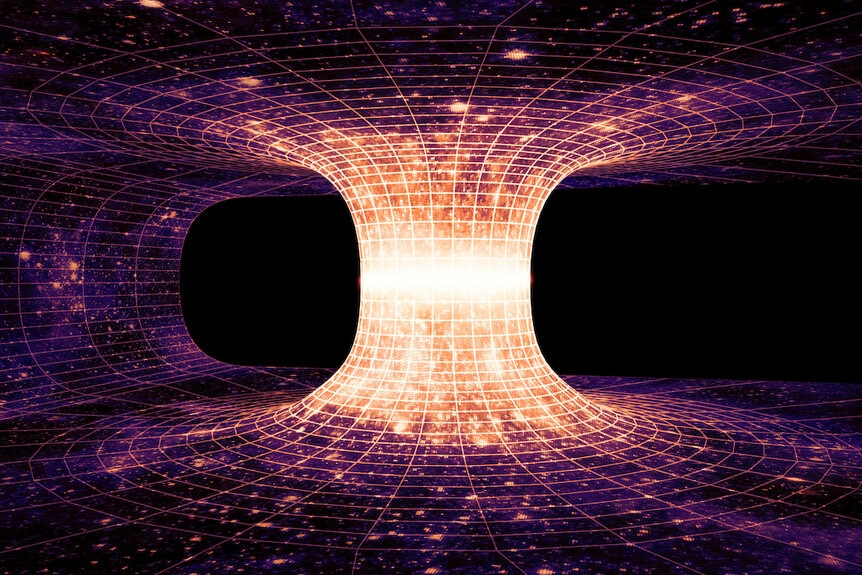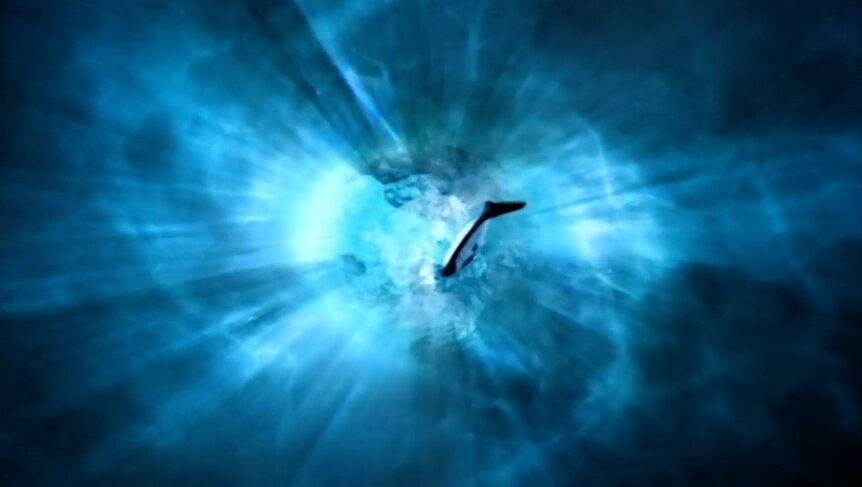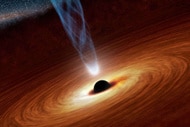Create a free profile to get unlimited access to exclusive videos, sweepstakes, and more!
Some Black Holes Might Actually Be Wrinkles in Spacetime
You can pull the threads of reality, but you might not be able to unpull them.

Black holes might be gargantuan cosmic monsters gobbling up everything they can get their grubby gravitational hands on, or they might be the secret to interstellar space travel, at least according to our favorite fictions. In the classic sci-fi series Farscape (now streaming on Peacock!), John Chrichton (Ben Browder), a modern day (circa 1999) astronaut, prepares to embark upon an experimental spaceflight mission when he encounters a nearby wormhole. Traveling through it, Crichton is delivered to a distant part of the universe, filled with conveniently humanoid alien peoples.
If those of us in the real world ever want to have our own Farscape adventures, we’re going to need a reliable wormhole highway to cut the travel time. One way to construct a wormhole involves strategically placed black holes, but the future constructors of our space travel superhighways might have to keep an eye out for weird quantum objects masquerading as black holes. A new study published in the journal Physical Review D, suggests that defects in spacetime could create false black holes.
ARE WORMHOLES AND BLACK HOLES THE SAME THING?
The short answer is no, and the longer answer is a qualified maybe. Black holes were predicted by Einstein’s General Relativity and confirmed to exist in 1971, when the black hole Cygnus X-1 was discovered. Black holes are born out of the deaths of incredibly massive stars. At the end of a star’s life, when it’s finished fusing material in its core, it will collapse under its own weight, pulling ever inward until it becomes a singularity.
RELATED: Where is the Cast of SYFY's Farscape Now? Ben Browder, Claudia Black & More
A person could presumably fly a spacecraft into a black hole, but it would be a one way trip. As they neared and crossed the event horizon, all of space and time would become distorted from their perspective, giving them an incredible if short lived window to the cosmos in the instant before they became a part of the singularity themselves, spaceship and all. In order to be a wormhole, there needs to at least be the possibility of coming out the other side someplace else. That’s just not something black holes offer. They’ll take anything you have to offer, even light, but they’re not keen on giving anything back.
Fortunately, the same math which allows for the existence of black holes also suggests the existence of their opposite: white holes. White holes would also have an event horizon, just like a black hole, but you’d never be able to cross it. In the same way that a black hole’s event horizon, once crossed, can never be uncrossed, a white hole’s event horizon can be exited, but never entered. By connecting the singularities of a black hole and a white hole, you could potentially create a wormhole which funnels material into the black hole’s singularity and out the other side.
So far, astronomers have never seen any indication of a white hole in the actual universe, potentially dashing our hopes of interstellar space travel. However, it’s worth noting that black holes were originally thought to be a fun little thought experiment inside of General Relativity, until we realized they were real.
A SPACE WRINKLE IN BLACK HOLE’S CLOTHING
Humans are notoriously bad at imagining black holes. We invariably imagine them much larger than they actually are, probably because our feeble little meat minds aren’t equipped for dealing with very massive, very small things. When you hear the word “singularity” you probably imagine a really small but incredibly massive speck of stuff. LIke a grain of dust that weighs a gogillion pounds, but that’s not quite right. A speck of dust or a grain of sand, however small, still has dimension. Zoom in far enough and you’ll find width, depth. A bit of sand can look like a crushing boulder at the right scale. A singularity, by contrast, has no dimension. None. And that’s not something we can readily visualize. What does something look like when it definitely exists but has no spatial presence to speak of? It sort of looks like nothing, and that’s the problem.
To really get at what’s happening inside of a black hole — even that is a problematic description, there is no inside, but you get the idea — astronomers need to understand how gravity works on incredibly small scales. A reliable theory of quantum gravity remains one of the biggest open questions in modern science.
The leading candidate for an explanation of quantum gravity is string theory. It suggests an alternate model of reality which ditches the three traditional spatial dimensions in favor of… well, more. There are a few different models, each of which are supported by math and observation to varying degrees. Superstring theory suggests the existence of 10 spatial dimensions, including the three we’re accustomed to. M-theory adds an additional dimension, bringing the total to 11; and bosonic string theory requires a total of 26 spatial dimensions, plus time.
You might be looking around right now, wondering where these other dimensions are. A quick experiment will confirm that you can pick up an object and throw it up or down, left or right, and forward or back, but that’s it. There’s nowhere else to go and, once again, we struggle to imagine what it would even look like if there were. Adding a spatial dimension means extending 90 degrees away from the existing dimension. For example, if you start with a one-dimensional line and connect another line at 90 degrees, you now have a two-dimensional object (or plane) with both length and depth. Pull that plane up (or down) 90 degrees from its surface and you’ll have a three-dimensional object. Adding a fourth spatial dimension therefore, requires extending a 3D object by another 90 degrees. That’s enough to break most people and we haven’t even thought about the six additional dimensions, at minimum.
If there are other spatial dimensions, and the math seems to suggest there are, we don’t seem to have access to them. That might be because they are only perceptible at incredibly small scales. That’s where the strings of string theory come in. Instead of point-like particles serving as the fundamental building blocks of reality, string theory substitutes a series of one-dimensional strings twisted up inside additional spatial dimensions.
We can’t see those dimensions, but we can demonstrate them in experiments. String theory can accurately describe the universe we see around us in a lot of important ways, but only when you add in enough extra dimensions to make the numbers add up. Those extra dimensions, however, could also create some bizarre consequences, which we might be able to identify.
The new study indicates that these tightly packed spatial dimensions required by string theory could cause permanent defects in the fabric of spacetime. Imagine the way threads of a garment can get tangled, bunched up, or loosened through the ordinary action of wearing and washing it, and you’re somewhere close to the truth. These defects, called topological solitons, are theoretical objects which are allowed by string theory and could look and behave an awful lot like black holes.
Researchers modeled the way light would behave in the presence of a soliton and the results were strikingly similar to the way light behaves around a black hole. In simulations, when light interacted with a virtual soliton, it bent around it and formed stable orbital rings and a shadow. If we put an image of light around a soliton in a lineup with images of a black hole, we might struggle to tell them apart.
That isn’t to say that all black holes are actually solitons. It’s way too early for that sort of conclusion, solitons might not actually exist. But if they do, we would be able to tell the difference between them and a true black hole if we looked closely enough. While they would bend light in a similar way, the mechanism of their spacetime distortion isn’t gravitational Which means they have no event horizon. You could fly as close to a soliton as you wanted without ever falling in. That’s good news for any unsuspecting astronauts from the late ‘90s but bad news for zipping off to cosmic parts unknown.
Good thing there’s always Farscape, streaming now on Peacock!




























